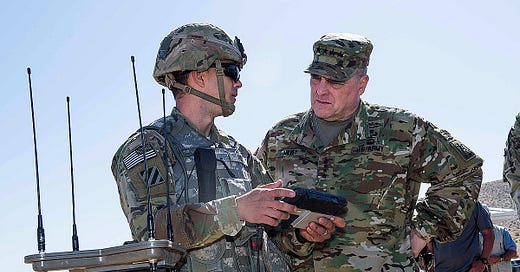Tech Bros Are in the Army Now
The Army’s Detachment 201 commissions tech execs to bring AI expertise to the military — merging innovation with national defense.
The U.S. Army is getting smarter — and not just figuratively.
Through a new initiative known as Detachment 201, the Army Reserve is commissioning top-tier Silicon Valley executives as officers to strengthen its capabilities in artificial intelligence, data science, and digital infrastructure. This experimental unit, informally known as the “Tech Bro Brigade,” aims to bridge the gap between private-sector innovation and military readiness.
While this initiative may seem novel, it’s rooted in a long-standing military tradition of tapping civilian expertise to meet urgent operational needs.
During World War II, the U.S. created the Office of Scientific Research and Development (OSRD), led by Vannevar Bush, to mobilize civilian scientists for wartime innovation. The OSRD helped develop critical technologies, including radar, the proximity fuse, and penicillin — and most famously, it oversaw the development of the Manhattan Project. These scientists remained civilians but were integrated deeply into the military’s planning and operations, demonstrating the strategic value of bringing outside talent into the fold.
The Korean and Vietnam wars offer another example. The military drafted civilian doctors and commissioned them as officers to serve in field medical units (such as depicted in the TV show M*A*S*H). These physicians were exempted from basic training and sent to combat zones based solely on their medical credentials. In many ways, Detachment 201 updates that model for a digital battlefield, where algorithms and analytics have become just as critical as scalpels and tourniquets.
More recently, the military has established pathways for cybersecurity and digital professionals through organizations such as U.S. Cyber Command and the Defense Innovation Unit (DIU). The DIU, along with its advisory counterpart, the Defense Innovation Board — originally chaired by former Google CEO Eric Schmidt — has helped the Pentagon rethink its approach to engaging with commercial technology companies. These initiatives laid the groundwork for a deeper integration of private-sector knowledge into defense strategy.
Internationally, programs like Detachment 201 are not unusual. Countries such as China and Russia have long maintained close relationships between their militaries and commercial technology firms.
In China, several of the country’s largest tech companies — including Huawei, ZTE, and Hikvision — have origins tied directly to military research and state-sponsored programs. Many senior executives at these companies, as well as their core technologies, trace their roots to institutions funded or operated by the People’s Liberation Army. The Chinese government has also promoted military-civil fusion as a national strategy, ensuring that innovations developed in the private sector are accessible for defense applications.
Russia follows a similar pattern of military integration with the technology sector. One of the most well-known examples is Kaspersky Lab, the cybersecurity company whose founder, Eugene Kaspersky, began his career in the Russian intelligence services. A graduate of a KGB-affiliated technical institute, Kaspersky worked on cryptography and information security for Soviet military intelligence before launching his private firm.
While Kaspersky Lab has consistently denied ties to Russian intelligence operations, questions about the company’s connections to the Kremlin and its software’s presence on foreign government systems have led to significant scrutiny and restrictions, particularly in the United States.
What sets Detachment 201 apart is its structure. Participants are given direct commissions at the rank of lieutenant colonel and are expected to contribute about 120 hours per year, often remotely. They will advise on technology acquisition, help train soldiers on AI systems, and support the development of digital strategies for the Army. Physical fitness and marksmanship tests are still required, though none of the tech officers will see combat. Unlike traditional reserve roles, these commissions are tailored for flexibility and focused purely on intellectual contribution.
Among the first cohort are several prominent technologists. Andrew “Boz” Bosworth, chief technology officer at Meta Platforms, accepted a commission as a lieutenant colonel and sees the opportunity as a continuation of his family’s military tradition. Shyam Sankar, Chief Technology Officer at Palantir Technologies, also holds the rank of lieutenant colonel and brings years of experience working on defense-focused data systems. Kevin Weil, a senior executive at OpenAI and an accomplished ultramarathoner, and Bob McGrew, another OpenAI alumnus, round out the founding team.
The motivations behind this program are clear: The U.S. military is facing escalating threats from adversaries using advanced technologies, including AI-guided drones and autonomous weapons. The traditional defense procurement system is often too slow and rigid to adapt to these changes in real time. Detachment 201 provides a practical approach to integrating cutting-edge expertise into military planning and execution.
The program is not without concerns. Both Meta and Palantir are active government contractors with lucrative defense deals. Palantir, for example, has a data integration and AI contract with the Army worth over $1 billion. Army officials insist that members of Detachment 201 will be firewalled from projects involving their employers and will not be in a position to benefit financially. Still, the potential for real or perceived conflicts of interest will need careful management.
Ultimately, Detachment 201 may prove to be a model for how the U.S. military keeps pace in a rapidly evolving technological landscape. By following in the footsteps of wartime scientists, field surgeons, cyber specialists, and now technologists, this new unit reflects a growing recognition that national security today depends as much on digital fluency as it does on traditional firepower.





